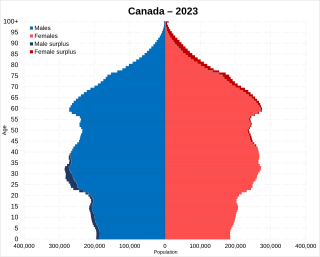
Statistics Canada conducts a country-wide census that collects demographic data every five years on the first and sixth year of each decade. The 2021 Canadian census enumerated a total population of 36,991,981, an increase of around 5.2 percent over the 2016 figure. It is estimated that Canada's population surpassed 40 million in 2023 and 41 million in 2024. Between 1990 and 2008, the population increased by 5.6 million, equivalent to 20.4 percent overall growth. The main driver of population growth is immigration, with 6.2% of the country's population being made up of temporary residents as of 2023, or about 2.5 million people. Between 2011 and May 2016, Canada's population grew by 1.7 million people, with immigrants accounting for two-thirds of the increase.

The 2000 United States census, conducted by the Census Bureau, determined the resident population of the United States on April 1, 2000, to be 281,421,906, an increase of 13.2 percent over the 248,709,873 people enumerated during the 1990 census. This was the twenty-second federal census and was at the time the largest civilly administered peacetime effort in the United States.

Canada ranks 36th by population among countries of the world, comprising about 0.5% of the world's total, with more than 40 million Canadians as of 2024. Despite being the second-largest country by total area, the vast majority of the country is sparsely inhabited, with most of its population south of the 55th parallel north. Just over 60 percent of Canadians live in just two provinces: Ontario and Quebec. Though Canada's overall population density is low, many regions in the south, such as the Quebec City–Windsor Corridor, have population densities higher than several European countries. Canada has six population centres with more than one million people: Toronto, Montreal, Vancouver, Calgary, Edmonton and Ottawa.

According to the 2021 Canadian census, over 450 "ethnic or cultural origins" were self-reported by Canadians. The country's ten largest self-reported specific ethnic or cultural origins in 2021 were Canadian, followed by English (14.7 percent), Irish (12.1 percent), Scottish (12.1 percent), French (11.0 percent), German (8.1 percent), Chinese (4.7 percent), Italian (4.3 percent), Indian (3.7 percent), and Ukrainian (3.5 percent).
The 2004 Moldovan census was carried out between October 5 and October 12, 2004. The breakaway Transnistria failed to come into an agreement with the central government in Chişinău, and carried out its own census between November 11 and November 18, 2004. The results of the census in Transnistria were put into question.
Statistics Canada conducts a national census of population and census of agriculture every five years and releases the data with a two-year lag.

The 2011 Canadian census was a detailed enumeration of the Canadian population on May 10, 2011. Statistics Canada, an agency of the Canadian government, conducts a nationwide census every five years. In 2011, it consisted of a mandatory short form census questionnaire and an inaugural National Household Survey (NHS), a voluntary survey which replaced the mandatory long form census questionnaire; this substitution was the focus of much controversy. Completion of the census is mandatory for all Canadians, and those who do not complete it may face penalties ranging from fines to prison sentences.

Ontario, one of the 13 provinces and territories of Canada, is located in east-central Canada. It is Canada's most populous province by a large margin, accounting for nearly 40 percent of all Canadians, and is the second-largest province in total area. Ontario is fourth-largest in total area when the territories of the Northwest Territories and Nunavut are included. It is home to the nation's capital city, Ottawa, and the nation's most populous city, Toronto.
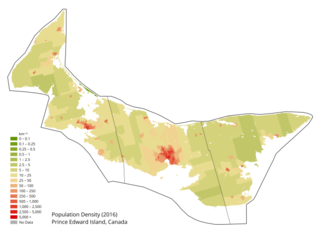
Prince Edward Island is a Canadian province. According to the 2011 National Household Survey, the largest ethnic group consists of people of Scottish descent (39.2%), followed by English (31.1%), Irish (30.4%), French (21.1%), German (5.2%), and Dutch (3.1%) descent. Prince Edward Island is mostly a white community and there are few visible minorities. Chinese people are the largest visible minority group of Prince Edward Island, comprising 1.3% of the province's population. Almost half of respondents identified their ethnicity as "Canadian." Prince Edward Island is by a strong margin the most Celtic and specifically the most Scottish province in Canada and perhaps the most Scottish place (ethnically) in the world, outside Scotland. 38% of islanders claim Scottish ancestry, but this is an underestimate and it is thought that almost 50% of islanders have Scottish roots. When combined with Irish and Welsh, almost 80% of islanders are of some Celtic stock, albeit most families have resided in PEI for at least two centuries. Few places outside Europe can claim such a homogeneous Celtic ethnic background. The only other jurisdiction in North America with such a high percentage of British Isles heritage is Newfoundland.
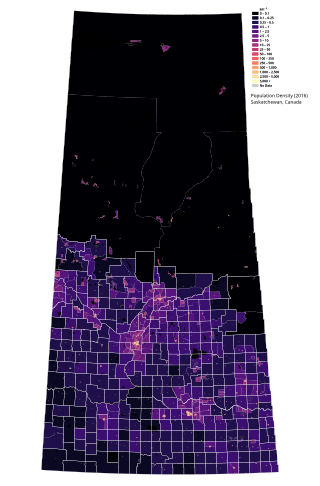
Saskatchewan is the middle province of Canada's three Prairie provinces. It has an area of 651,900 km2 (251,700 mi2) and a population of 1,132,505 (Saskatchewanians) as of 2021. Saskatchewan's population is made of 50.3% women and 49.7% men. Most of its population lives in the Southern half of the province.

Newfoundland and Labrador is a province of Canada on the country's Atlantic coast in northeastern North America. The province has an area of 405,212 square kilometres and a population in 2024 of 545,880, with approximately 95% of the provincial population residing on the Island of Newfoundland, with more than half of the population residing on the Avalon Peninsula. People from Newfoundland and Labrador are called "Newfoundlanders," "Labradorians", or "Newfoundlanders and Labradorians".
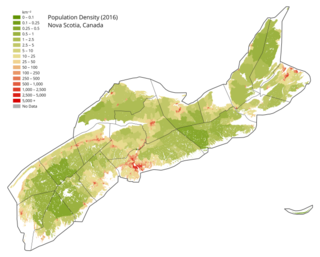
Nova Scotia is a Canadian province located on the country's southeastern coast. It is the most populous province in Atlantic Canada, and its capital, Halifax, is a major economic centre of the region. Geographically, Nova Scotia is the second smallest province in Canada, with an area of 52,824.71 km2 (20,395.73 sq mi). As of 2021, it has a population of 969,383 people.
The Northwest Territories is a territory of Canada. It has an area of 1,171,918 square kilometres and a population of 41,786 as of the 2016 Canadian census.
Yukon is the westernmost of Canada's three northern territories. Its capital is Whitehorse. People from Yukon are known as Yukoners. Unlike in other Canadian provinces and territories, Statistics Canada uses the entire territory as a single at-large census division.
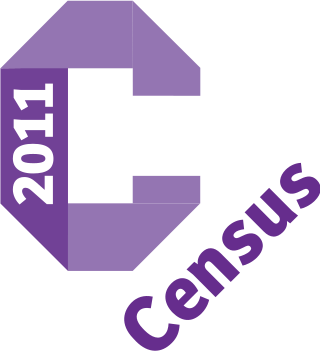
A census of the population of the United Kingdom is taken every ten years. The 2011 census was held in all counties of the UK on 27 March 2011. It was the first UK census which could be completed online via the Internet. The Office for National Statistics (ONS) is responsible for the census in England and Wales, the General Register Office for Scotland (GROS) is responsible for the census in Scotland, and the Northern Ireland Statistics and Research Agency (NISRA) is responsible for the census in Northern Ireland.

The South African National Census of 2011 is the 3rd comprehensive census performed by Statistics South Africa.
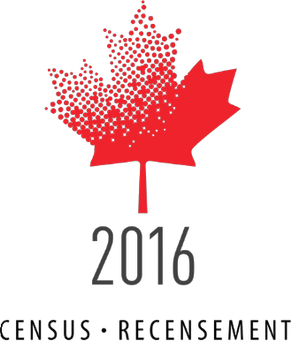
The 2016 Canadian census was an enumeration of Canadian residents, which counted a population of 35,151,728, a 5% change from its 2011 population of 33,476,688. The census, conducted by Statistics Canada, was Canada's seventh quinquennial census. The official census day was May 10, 2016. Census web access codes began arriving in the mail on May 2, 2016. The 2016 census marked the reinstatement of the mandatory long-form census, which had been dropped in favour of the voluntary National Household Survey for the 2011 census. With a response rate of 98.4%, this census is said to be the best one ever recorded since the 1666 census of New France. This census was succeeded by Canada's 2021 census.
The 1871 Canadian census marked the first regularly scheduled collection of national statistics of the Canadian population on April 2, 1871, as required by section 8 of the British North America Act. The constitution required a census to be taken in 1871 and every tenth year thereafter. Parliament implemented the requirements of the constitution through the Census Act of May 12, 1870. In the first census, the population of Canada was enumerated to be 3,485,761.

The 2021 Canadian census was a detailed enumeration of the Canadian population with a reference date of May 11, 2021. It follows the 2016 Canadian census, which recorded a population of 35,151,728. The overall response rate was 98%, which is slightly lower than the response rate for the 2016 census. It recorded a population of 36,991,981, a 5.2% increase from 2016. It will be succeeded by Canada's 2026 census.
The 2023 Census of Pakistan was the detailed enumeration of the Pakistani population and the seventh national census in the country. It was conducted by the Pakistan Bureau of Statistics. It was also the first ever digital census to be held in Pakistan, including the first in South Asian history.













